By Jeffrey A. Rendall, Photos By Jeffrey A. Rendall
FARMINGTON, PA – “I can’t build a golf course here,” replied Pete Dye, after looking over a piece of property owned by Joe Hardy at Nemacolin Woodlands Resort. Hardy was collecting Dye’s thoughts on the land’s potential to build a world-class golf course, which he wanted to add to the growing resort’s recreational offerings. And despite Dye’s initial reluctance, Hardy got his wish – Dye designed what today is known as Mystic Rock.
Who could blame Dye for his pessimistic first impression? Before him lay one of the most rugged, rocky landscapes in the Keystone State (or anywhere else, for that matter), barely suited for a mountain goat, much less a clique of sharply clad resort golfers.
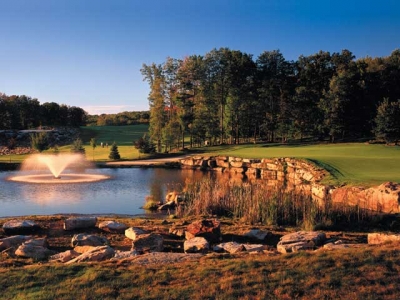 |
| Mystic Rock's signature par three 12th hole. Photo Courtesy of Nemacolin Resort. |
Dennis Clark, Nemacolin’s Director of Golf, takes the story from there: “Mr. Hardy’s motto is ‘Nothing Is Impossible,’ so he told Dye to do whatever he thought necessary to build him a golf course on top of that rock. Dye agreed to do it, but only under one condition – that Hardy never ask him how much he spent building it.”
“To this day, I don’t think anybody really knows exactly how much that phase of Mystic Rock’s history actually cost,” Clark added.
It must’ve been significant. Mystic Rock opened in 1995, and has become Hardy’s eternal work-in-progress project ever since. Though it was certainly beautiful from the start, the layout has undergone significant changes – in Hardy’s insatiable quest to shape it into a Major Championship-caliber test. The course is currently being readied to host the 2nd annual ’84 Lumber Classic,’ and this year’s field includes world number one ranked Vijay Singh (feels weird to say that) and the number one crowd favorite everywhere he goes, John Daly.
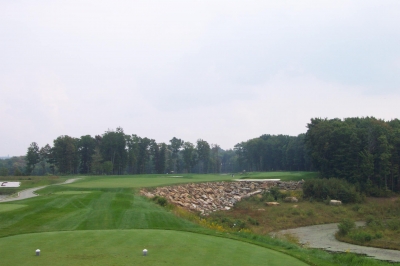 |
| The par four 2nd hole. Here's where you see the rock for the first time, and you've got to fly your tee shot over it. |
More than ‘just’ a PGA Tour venue, however, Nemacolin’s resort guests ‘own’ access to its fairways the rest of the year. True to its name and Dye’s initial impressions, you’ll see tons of rock all around – but thankfully, acres and acres of green grass in addition. Dye’s courses are notoriously friendly to the resort golfer playing advanced sets of tees, where the majority of scorecard calculations stem from trying to decipher Dye’s short-game challenges around the greens, not from needing to blast it long and straight off the tee box.
“Not everyone can hit a 300-yard drive,” Dye once said. “But anyone, even the lady high-handicapper can hit shots around the green. You don’t have to be Phil Mickelson to come up with that one-in-a-hundred shot, so I’m liable to put anything around the greens.”
And so he did at Mystic Rock. Clark said the course has now been stretched out to nearly 7,500 yards for the arrival of the PGA Tour, but its fairways are still generous and there are a plethora of short-game tests waiting the professionals, as well as resort guests once the Tour leaves town.
 |
| Mystic Rock hosts the PGA Tour's 84 Lumber Classic. |
Dye said building Mystic Rock was truly unique in his estimation, and that’s saying a lot for the man who’s had unprecedented influence in the era of modern golf design: “That property was just an unbelievable rock pile. Sure, you still see a lot of rock when you’re playing it, but we probably buried ten times as much rock as you can see. We blasted for six months before we even started on the dog-gone thing, then filled in the ravines with what we’d removed.”
What was left, in Dye’s estimation, was a pretty darn challenging layout. In the usual Dye fashion, he designed some wicked slopes in the greens, yet can’t understand what all the ‘severe’ talk was about during the ’03 84 Lumber Classic. The commentators spoke time and again about how sloped the greens were.
“Those greens aren’t that severe at all,” Dye retorted. “You didn’t see the ball rolling off them, or anything like that. As a matter of fact, we contoured a lot of those greens so they’d be receptive – so if you put a pin in a certain place, the approach shot would bounce into the pin. I don’t know how those reporters sit there and say the greens are severe when you watch the ball land twenty feet from the pin and roll towards the hole in a flat area. Damn if I can tell you.”
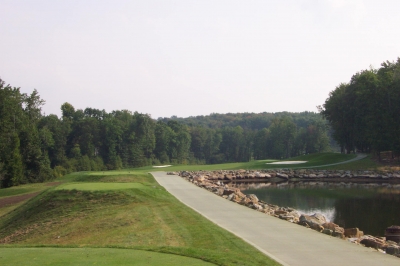 |
| The view from the 10th tee. You've just played one of Mystic Rock's toughest holes, and it doesn't get any easier from here. |
“Mystic Rock was built at a resort, so those greens would help the resort player. They kept saying the greens were severe, yet for four days, I never saw anybody three-putt a single green,” Dye said.
Dye’s not being defensive, he’s trying to make a point. Last year’s winning score was 22-under, including a final round 62 by the tournament’s champion, J.L. Lewis -- doesn’t sound to me like the course was taking too much away from the professional.
Clark says there’ve been changes since last year, and this year’s scores should be much more in line with Mystic Rock’s rating of 77.6 and slope of 149. “Last year, we were dealing with the effects of all the rain we got from Hurricane Isabel, which made the already wide fairways wider, and the greens were pretty soft, too. The Tour allowed the players to lift, clean and place, so there was very little to protect against the scores.”
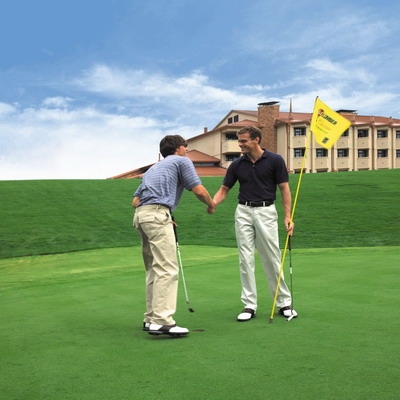 |
| You'll finish up the round in front of Mystic Rock's brand new clubhouse, Falling Rock. Photo Courtesy of Nemacolin Resort. |
“This year, we’ve lengthened the course, and all eighteen greens were rebuilt and re-contoured. Last year, the average size of the greens was 8,200 square feet, and this year, it’s 6,100. And because of the greens’ contours before, it essentially restricted the number of pin placements we could use – so we had to use all the flat parts. The pros ate ‘em up,” Clark said.
Ah, so that’s where the ‘severity’ criticism came from, and answers why the PGA players were able to score so low. Because the greens were formerly so sloped, the pros were essentially hitting to the pin placements that Dye mentioned above – to the places where the ball would filter towards the hole. Professional players, resort pins – bad combination.
Not this year. Daly and Vijay (amongst others in a pretty impressive field) are going to find it different sailing for the 2004 version of the 84 Lumber Classic, but the resort players will still enjoy their advantages after it’s concluded. The course will play much firmer and faster, which is the way it was designed to play.
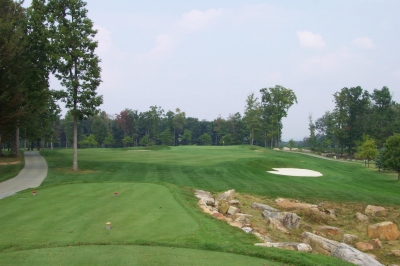 |
| The par three 3rd hole is a good example of a hole that's changed -- the green is much smaller than last year, so you've got your work cut out for you. |
That’s not all that’s different.
“We flattened the greens,” Clark said. “We essentially made them so we could tuck pins, as well as bring the greens’ defenses into play, such as bunkers and water. We’ve also narrowed some of the fairways by adding bunkers, or enlarging the ones that were already there. Then we’ve added a few greenside bunkers as well, or brought others closer to the green, which were previously not in play for the better player.”
What you see out on the golf course aren’t the only improvements to Mystic Rock, or to Nemacolin Resort. As hinted at earlier, it’s a facility-wide evolution towards perfection, with the ultimate goal being to host a future Major Championship, according to Clark.
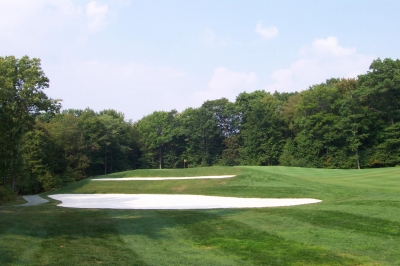 |
| The par five 8th hole's green is one of the most controversial, since even good shots tend to roll off the back. |
Helping in that quest are a completely new driving range and perhaps the biggest addition of all, a new clubhouse. Clark said there were several nudges from last year’s Tour players, who ‘suggested’ that a new clubhouse would add to their desire to return.
As you may have gathered, Joe Hardy doesn’t do anything halfway. Such is certainly true for the new clubhouse, called ‘Falling Rock,’ a Frank Lloyd Wright inspired design that Vijay Singh called the finest golf clubhouse in America. That’s high praise from someone who should know.
It should be fine. The tab for Falling Rock was in the tens of millions – but again, Hardy dreams big and then brings in the talent to ‘build’ them into existence. Not bad for ten months’ work, about four of which were snow covered.
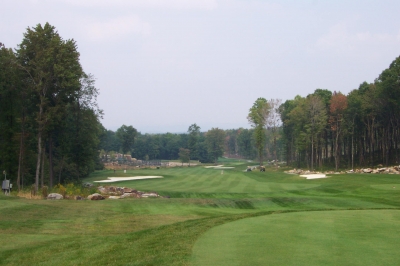 |
| Looking from the tee of the par five 5th -- plenty of fairway out there, so go find it. |
With all that’s going on at Mystic Rock, thankfully there was one area that needed no adjustment whatsoever, because Dye did such an outstanding job on it in the first place – the routing of the layout.
“I’ve rated courses for years for Golf Digest,” Clark explained. “Every time we rate a course, we go on variety, continuity, conditioning, shot-making values and routing. I think Mystic Rock rates tremendously high because of its routing – you never play two consecutive holes going in the same direction, and the par threes are all laid out facing different directions. There are eighteen separate challenges, but the genius of the architect here is that he blended them all into one unit. So there’s tremendous variety, as well as continuity.”
And Dye’s worked it so that the resort player won’t feel slighted – taking hazards and carries out of play that would spoil an otherwise great golf experience. You won’t lose a lot of golf balls here, but you’ll probably walk away feeling that you should’ve scored better. Because of the precision demanded on the short shots at Mystic Rock, you’ll be spending a lot of time with wedge and putter in your hands – then with the pencil back at the cart.
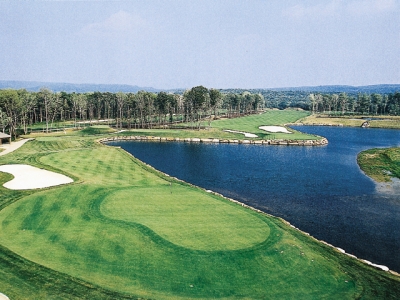 |
| From up above the par three 17th and par five 16th. Photo Courtesy of Nemacolin Resort. |
Clark described Mystic Rock as a second-shot golf course for resort golfers as well as pros – where the landing areas for both types of players are essentially the same, and then they’ll have to take on similar yardage to the greens. It’s the pros’ preponderance of talent in the final 150 yards of each hole that subtracts dozens of strokes from their scores, not their ability to hit it a hundred yards farther off the tee.
Because of the focus on getting the course set up to host the professional tournament, however, there were a few things that kind of threw us for a loop – for example, the placement of a large pot bunker right smack in the middle of the landing area on the fourteenth hole (which isn’t visible from the tee). But instead of passing it off as a Dye-anomaly, Clark provides the explanation:
“Vijay Singh played in an exhibition here with Rocco Mediate, and I was Master of Ceremonies for the event. On the fourteenth tee, Vijay asked me how far it was to clear the fairway bunker on the right, and I told him 305 yards,” Clark elaborated. “Without even hesitating, he put his ball on the peg and ripped it right over that bunker. Over 305 yards in the air -- you had to see it to believe it.”
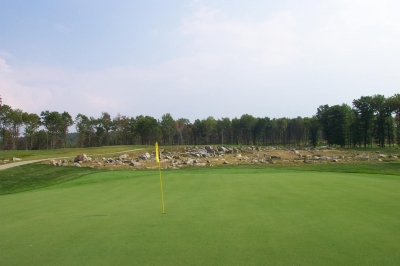 |
| Thankfully, Dye doesn't put much of the rock in play -- but you can see it from all different angles. Here, looking back towards the tee on the par three 7th hole. |
“When Pete heard about that, he told Mr. Hardy to ‘go out and dig the deepest (gosh darned) bunker that you can, beyond that fairway bunker, because I don’t want anybody to be able to just ace that hole because the damned golf ball flies so far now.’ So, that’s why there’s a pot bunker right in the middle of the landing area, which really should only come into play for the guys who can blast it that kind of distance,” Clark added.
Thanks to Clark for not censoring the colorfulness of Pete Dye. If you think Dye’s golf courses are vivid, you should hear him speak. Quite a fascinating man, indeed.
There’s little doubt that Hardy and Dye will succeed in their mission to mold Mystic Rock into something even more unique and special. According to Clark, comments from the players at this year’s tournament will factor into the changes for next year – and it’ll go on until the course receives the kind of recognition that Hardy aspires to. It’s no secret that he’d like to host big things at Mystic Rock in the future – and his track record proves he’ll dedicate the resources to get it there.
You’d expect nothing less from two men who manufactured a golf course out of a pile of rocks.
Note: Click here for an overview of Nemacolin Resort.
Details:
Mystic Rock at Nemacolin Woodlands Resort
Route 40
Tee times: (724) 329-8555
Website: www.nemacolin.com
Course Designer: Pete Dye
Nemacolin’s Owner: Joe Hardy
Director of Golf: Dennis Clark, PGA
Head Golf Professional: Joe Nieporte, PGA
Tees/Yardage/Slope/Rating
Championship 7,400+ 149/77.6
Blue 6908 143/74.3
White 6300 139/70.9
Gold 5860 132/69.7
Red 4800 125/68.8
Rates:
Seven days a week, $130 for resort guests, $150 for non-guests. Twilight is $84, weekdays after 3.
Price includes cart and range privileges.
Walking is not permitted.
Consult Nemacolin’s website for package pricing, which includes accommodations and recreational activities, including golf.
To purchase tickets to the 84 Lumber Classic: 1-888-356-8484
| Related Links | Comments on this article? | |
|
Maryland National Golf Club Hollow Creek Golf Club Rocky Gap Resort PB Dye Golf Club in Ijamsville Whiskey Creek Golf Club |
E-mail Jeff Rendall, Editor: jrendall@golftheunitedstates.com |












